 Many children who struggle with prioritization and planning in time management seem to be lost, appearing to tread water without any clear direction. They often require external support and need to have an understanding adult who recognizes that slow processing or a specific learning issue may be interfering with efficient time management. In this edition of the LearningWorks for Kids Beyond Games series we suggest strategies that can help a child improve prioritization, planning, and time management.
Many children who struggle with prioritization and planning in time management seem to be lost, appearing to tread water without any clear direction. They often require external support and need to have an understanding adult who recognizes that slow processing or a specific learning issue may be interfering with efficient time management. In this edition of the LearningWorks for Kids Beyond Games series we suggest strategies that can help a child improve prioritization, planning, and time management.
Break bigger tasks into smaller ones. Budget time spent on tasks by segmenting larger tasks into portions that are to be accomplished on certain days and times. For example, for a child who has a science fair project that is due in a month, divide the month into weeks and require that certain parts of the project be done by the end of each week.
Post a large, monthly family calendar at home. Post schedules throughout the household for appointments and events. Prioritize events for the entire family on a large monthly calendar with different colored markers. Make it known that your yourself plan to use your time efficiently, using seemingly free time in between tasks to work on other things. Encourage a child to use a similar process of prioritizing the completion of homework, play dates, chores, and extracurricular activities.
Responsibilities mean privileges. A child may be more apt to complete things on time and maintain good prioritization if she is rewarded for this type of behavior. Allow her to watch a favorite movie or television program on a night when she has budgeted her time well in completing her homework or take her to her favorite restaurant for a meal when she has finished a project for school on time.
Look to the root of the problem. Difficulty with time management or a tendency to move very slowly can be related to a particular area for a particular child. Children who tend to process verbal information slowly may need to have directions repeated or related slowly. Others may readily understand verbal directions but have a harder time completing a written task. A child may need alternative methods to produce what she needs to complete.
Complementing these core strategies with the use of apps, websites, and other technologies often leads to the best solutions to improve a child’s ability with time management. Some of the best tech tools to help a child improve his prioritization and planning in time-management skills include:
![]() Boximize is a slick iOS app recommended for kids 10 and older that allows the creation of to-do lists, verbal note-taking, task management, and itemization of materials. Kids with specific needs can set up their own interface to keep track of anything they desire or require. Boximize is a one-stop app for building planning, organization, and time management skills.
Boximize is a slick iOS app recommended for kids 10 and older that allows the creation of to-do lists, verbal note-taking, task management, and itemization of materials. Kids with specific needs can set up their own interface to keep track of anything they desire or require. Boximize is a one-stop app for building planning, organization, and time management skills.
 In order for a concept to stick, it often helps to make it fun. Hotel Dash will give kids an appreciation for the skill of prioritization and how it relates to juggling real world responsibilities. As Flo, a hotel employee, they will need to keep up with guest demands and use their time most efficiently, requiring the planning and execution of multiple tasks to keep everything running smoothly.
In order for a concept to stick, it often helps to make it fun. Hotel Dash will give kids an appreciation for the skill of prioritization and how it relates to juggling real world responsibilities. As Flo, a hotel employee, they will need to keep up with guest demands and use their time most efficiently, requiring the planning and execution of multiple tasks to keep everything running smoothly.
 ChoreMonster is an app we’ve recommended more than once because its concept is such a novel one. ChoreMonster combines business and pleasure by making real life responsibilities, like chores, seem like a video game. The visually appealing app keeps track of a child’s to-do list (it offers a parent side and multiple kids’ accounts), allowing due dates, alarms, and the addition of visual aids to maximize success. Parents can determine how many points a task is worth, with rewards earned with certain point totals.
ChoreMonster is an app we’ve recommended more than once because its concept is such a novel one. ChoreMonster combines business and pleasure by making real life responsibilities, like chores, seem like a video game. The visually appealing app keeps track of a child’s to-do list (it offers a parent side and multiple kids’ accounts), allowing due dates, alarms, and the addition of visual aids to maximize success. Parents can determine how many points a task is worth, with rewards earned with certain point totals.
Featured image: Flickr user Sharon Mollerus




